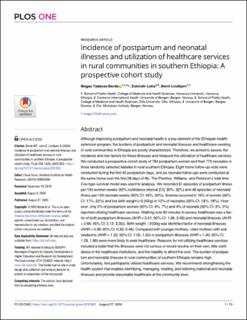| dc.description.abstract | Although improving postpartum and neonatal health is a key element of the Ethiopian health extension program, the burdens of postpartum and neonatal illnesses and healthcare-seeking in rural communities in Ethiopia are poorly characterized. Therefore, we aimed to assess the incidence and risk factors for these illnesses and measure the utilization of healthcare services. We conducted a prospective cohort study of 784 postpartum women and their 772 neonates in three randomly selected kebeles in rural southern Ethiopia. Eight home follow-up visits were conducted during the first 42 postpartum days, and six neonate follow-ups were conducted at the same home over the first 28 days of life. The Prentice, Williams, and Peterson’s total time Cox-type survival model was used for analysis. We recorded 31 episodes of postpartum illness per 100 women-weeks (95% confidence interval [CI]: 30%, 32%) and 48 episodes of neonatal illness per 100 neonate-weeks (95% CI: 46%, 50%). Anemia occurred in 19% of women (95% CI: 17%, 22%) and low birth weight (<2,500g) in 15% of neonates (95% CI: 13%, 18%). However, only 5% of postpartum women (95% CI: 4%, 7%) and 4% of neonate (95% CI: 3%, 5%) reported utilizing healthcare services. Walking over 60 minutes to access healthcare was a factor of both postpartum illnesses (AHR = 2.61; 95% CI: 1.98, 3.43) and neonatal illnesses (AHR = 2.66; 95% CI: 2.12, 3.35)). Birth weight ≥2500g was identified factor of neonatal illnesses (AHR = 0.39; 95% CI: 0.33, 0.46). Compared with younger mothers, older mothers with sick newborns (AHR = 1.22; 95% CI: 1.00, 1.50) or postpartum illnesses (AHR = 1.40; 95% CI: 1.03, 1.89) were more likely to seek healthcare. Reasons for not utilizing healthcare services included a belief that the illnesses were not serious or would resolve on their own, little confidence in the healthcare institutions, and the inability to afford the cost. The burden of postpartum and neonatal illnesses in rural communities of southern Ethiopia remains high. Unfortunately, few participants utilized healthcare services. We recommend strengthening the health system that enables identifying, managing, treating, and referring maternal and neonatal illnesses and provide reasonable healthcare at the community level. | en_US |

